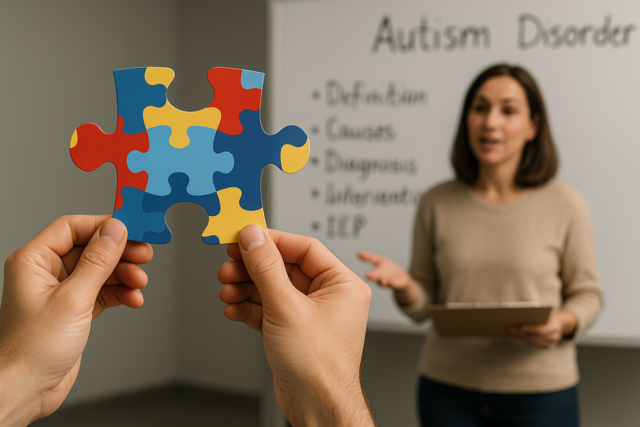Introduction
Numerous factors cause learning disabilities, and each of them affects different areas or centers of the brain. In this article, we'll focus on a handful of causes of learning disabilities and briefly define them to give parents, teachers, and family members a greater understanding of how broad the realm of a learning disability really is. Much like a line of dominoes, one learning disability can affect another aspect of learning or academic development.
Our list and descriptions of the causes of the most common learning disabilities is not complete, and should not be used as a tool for self-diagnosis. Rather, utilize the information as a guideline to help parents, teachers, and friends or family members to more easily identify early signs of problems in learning, so that more timely and relevant interventions can be determined.
In this section, we'll briefly define and describe some of the most common causes of learning disabilities. Again, this list is not all-inclusive and as every child is different, should not be used as a tool to diagnose, but rather as a tool to guide and direct parents and teachers toward a correct diagnosis.
Dyslexia
Dyslexia is a type of learning disorder that is most often characterized by a difficulty in reading. Dyslexia is classified as the most common learning disorder or disability in children of school age.
The most common symptoms of dyslexia in pre-K children is delayed vocabulary and talking development. School-age children may read below expected levels, experience difficulty recognizing the difference between letters and words, as well as difficulty pronouncing new words. The child with dyslexia will often reverse letters or words, such as b for d, or reversing words such as was for saw.
During their teen and adult years, an individual experiencing dyslexia may experience difficulty with reading, either silently or aloud. Memorizing, and summarizing stories, is often difficult. Adults with dyslexia may have an extremely difficult time learning a foreign language, and some experience trouble when it comes to time management.
In most cases, most children are reading primers in kindergarten or first grade, while a child struggling with dyslexia will not.
Dysnomia
Dysnomia affects learning capabilities, and is also called anomic aphasia. A person with dysnomia may have difficulty recollecting names or words. While we all have trouble remembering someone's name or word once in a while, a person with dysnomia experiences chronic difficulties in such recollections.
For example, an individual with this type of learning disability may know exactly what to do with a specific object, or how it functions, but can't actually name it. It is believed that 'anomia' or dysnomia, is caused by damage to the brain, usually through brain trauma, tumor, or accident. It affects the area of the brain that controls the speech production, execution, and comprehension.
Patience, constant reinforcement, and encouragement is required when dealing with any child or adult experiencing dysnomia.
Dyscalculia
Dyscalculia is the medical term for a disability in comprehending or dealing with mathematical or numeral calculations and arithmetic. As a math learning disability, dyscalculia is often identified in early elementary school years, and involves more than just numbers.
Some of the most common symptoms of dyscalculia include difficulty with time, direction, and understanding sequences of events. A child experiencing dyscalculia will have very poor ability in mathematical subjects including addition, subtraction, multiplication and division, let alone more abstract and rational thinking as required by other subjects including algebra and geometry.
Adults struggling with dyscalculia may have difficulty balancing a checkbook, experience poor money or credit management skills, and inability to mentally determine change, or calculate taxes or tips.
Most commonly, individuals with dyscalculia have an inability to remember and grasp math rules, formulas, orders of operations, and basic math concepts. Some days, the child or adult will be capable of performing basic math functions, while the next day, not remember anything about it. For example, a child may be able to complete workbook exercises, but then later score very poorly or fail on quizzes and tests.
Dysgraphia is defined as a difficulty in writing � printing or cursive handwriting. The condition is neurological in origin, and for children, is recognized early on as the child is unable to create appropriately spaced and sized letters, even following one-on-one instruction. Such children often not only misspell words, but write the wrong word in attempting to describe something. Children diagnosed with dysgraphia may also experience additional learning disabilities, including those involving reading.
Some of the most common signs of dysgraphia include but are not limited to awkward pencil grip, extremely illegible handwriting, and difficulty in spelling or finding the right words to describe an idea, object, or word. Many children with dysgraphia say the word out loud while the writing it down, but may have difficulty in creating complete sentences.
Teenagers or adults with dysgraphia avoid writing as much as possible, and often experience extreme difficulty with organizing letters, words, and numbers in a straight line on a page. This is often caused by difficulty or inability to process what their eyes see, known as a visual spatial difficulty.
Dyspraxia
Dyspraxia is a term that defines a disorder in development of motor skills. For example, a person with dyspraxia may have difficulty performing relatively simple tasks, such as clapping, waving, brushing their hair, their teeth, or other fine motor movements.
Statistics show that larger groups of males than females experienced dyspraxia, and of the 2 percent of the overall U.S. population diagnosed with the condition, approximately 70 percent of those are male. It is estimated by the National Center for Learning Disabilities, that up to 6 percent of children show some signs and symptoms of the condition.
While dyspraxia is certainly less common than dyslexia, it can cause not only difficulty in pronouncing words, but problems with physical capabilities and coordination. Often existing in conjunction with dyslexia or dyscalculia, a child or adult struggling with dyspraxia will have difficulty in processing information, written and verbal comprehension, and difficulty with comprehending auditory instructions.
In preschool children, one of the most common warning signs of dyspraxia is difficulty in pronouncing words, as well as being able to speak and be understood. School-age children have trouble grasping pencils, and may experience difficulty forming letters as well as exhibit extremely slow printing or handwriting skills. An adult with dyspraxia may have difficulty with both writing and typing skills, and in speech control involving pitch and articulation.
Brain injury, trauma, or disease processes -- such as tumors, surgery, and cancers -- may cause a number of learning disabilities, depending on the area of the brain affected. Traumatic brain injury, regardless of cause may affect a person's ability to:
- Talk
- Think in an abstract manner
- Solve problems
- Pay attention
- Understand words
- Remember
- Think and reason
Some traumatic brain injuries occur during the birth process, while some children and adults may experience a brain injury following an illness, a disease process such as cancer, or blunt force trauma caused by an auto accident or a fall. In some children and adults, a traumatic brain injury can make it difficult for a person to speak properly, or to comprehend what is spoken to them. A child or adult may experience more difficulty in completing tasks, and needs more time to do so.
Statistics have determined that nearly 1.7 million people experience a traumatic brain injury on a yearly basis, and children up to 19 years of age make more than 500,000 trips to an emergency room every year, according to the National Dissemination Center for Children with Disabilities.
A brain injury can be mild or severe, again depending on the type and severity of trauma, the damage done, the area of the brain affected, and short- and long-term prognosis.
Genetic and hereditary factors may also affect learning. For example, dyslexia may be classified as a hereditary learning disability, but not always. Scientists are currently studying gene research when it comes to causes of learning disabilities, and nearly 80 genes have been specifically identified in learning disabilities. To date, the actual possibility of genetic causes for learning disabilities has not yet reached adequate understanding; the complexity makes it difficult to pinpoint a specific cause in regard to hereditary factors.
Causes of learning disabilities are many, and are not always easily identified or even recognized. Regardless of the cause, it's important for parents and teachers to notice when a child or an adult is struggling with a certain subject or concept in school, their social environment, or on the job. Understanding how learning disabilities are diagnosed in classified is extremely important not only for parents, but professionals in a wide range of environments and scenarios.
How Learning Disabilities Are Diagnosed and Classified
Introduction
Diagnosing or classifying a learning disability is not always as simple as black and white. As we continue throughout this course on learning disabilities, we encourage parents and teachers to resist the urge to "diagnose" on their own. In addition to the causes of learning disabilities mentioned in the previous lesson, it must always be remembered that children (from tots to college students) learn at different paces, depending on personality, upbringing, and emotional and mental maturity.
In this lesson, we'll briefly explain how learning disabilities are diagnosed, through a variety of assessment processes. We'll also introduce students to various accommodations that are often made by educators when dealing with changes in condition; and we'll cover the concept of devising and catering instructional plans based on developmental skills. Finally, we'll conclude with a brief explanation of the 504 Plan, sponsored by the National Center for Learning Disabilities.
Diagnosing a Learning Disability
In an earlier lesson, we briefly defined some of the most common signs and symptoms of a learning disability based on age/grade levels. Assessment and diagnosis is also based on age. Testing and diagnosis of a learning disability takes time, and just because a person has one or two symptoms doesn't mean he or she has a learning disability.
Not all doctors are specialists in understanding developmental skill levels based on age, and while pediatricians are often more familiar with average developmental skills in younger children, again, many are not familiar enough with the wide variety of learning disabilities from toddlers to older teenagers that may offer them a clear and concise diagnosis of a learning disability.
Parents should also be forewarned that some doctors tend to minimize parental concerns regarding learning speed and development, and in such cases, parents are encouraged to seek additional opinions. This also takes time and money. Parents should also be aware that it's not uncommon for medical experts to misdiagnose ADHD with a learning disability or vice versa, especially when behavioral issues are involved.
It is recommended that parents, through following up on their concerns, not be overly focused on finding a specific label for their child, but to encourage the child through guidance, one-on-one support, and plenty of patience and understanding.
Professionals involved in testing and diagnosing for a learning disability are extensive, and can involve:
- Child and/or school psychologists
- Clinical psychologists
- A psychologist focusing on education, development, or clinical aspects of psychology
- A speech and language therapist
- Neuropsychologist (depending on symptoms)
- Psychometrist (a branch of psychology focusing on interpretation of tests as a measurement of intelligence, aptitude, and often, personality traits)
In many cases, it may take more than one professional to determine an accurate diagnosis of a learning disability, and input from parents, teachers, friends and family members may also be requested.
In many cases, an assessment process may be recommended. A similar process is followed for all age groups, and contains basic areas of assessment including:
- Intake - This aspect of the assessment involves gathering information regarding an individual's personal, educational and medical history. This may include social history, genetic history, and familial history, especially when brothers and sisters who may or may not have similar difficulties in learning are present.
- Achievement testing - This aspect of the assessment takes into consideration grades, reports, and descriptions from teachers, parents, or others closely involved with the individual regarding their past and present academic skill levels. Basic areas under study include reading and writing, math, and spelling.
- Intellectual ability testing - This part of the assessment process involves testing of the child, teenager, or adult regarding their potential for academic learning -- for example, determining the individual's most common difficulty, whether in spelling, reading comprehension, writing, and so forth. Understanding where the difficulty lies often helps experts determine the potential for that person to meet and overcome the obstacles, challenges, and difficulties associated not only with that particular subject matter, but associated and overlapping skills in learning development.
- Interpretation - This aspect of the assessment takes into consideration all the gathered research and materials from the above three areas of focus, after which documents and data are reviewed, and recommendations are then made.
Of course, professionals may take a slightly different approach during the assessment process, based on the individual's age, as well as issues presented by parents and/or teachers.
The assessment process for adults may be more complicated, according to the Learning Disabilities Association of America. For example, such assessments may also include screening for auditory or visual processing issues, as well as vision and hearing difficulties. Behaviors and psychological background are also studied in detail.
In many cases, the assessment process is also known as a screening,and in the case of adults, many may also offer their own experiences, feelings, and expression of challenges or obstacles they face in regard to their learning disabilities background.
A few basic and very common questions that experts may observe, in both children and adults, include:
- Does the child/adult show obvious signs of either poor hearing or vision? During a question-and-answer session, a doctor may also determine whether he or she observes a visual or auditory processing deficit.
- The medical expert will also request information, either written or oral, regarding intellectual and social capability status of the individual. For example, is the child or adult an underachiever? Or does he or she exhibit an average ability in social skills and intellectual development?
- As in the above assessment protocol, the medical expert also determines whether the child or adult is having academic performance issues in either oral or silent reading, expressive language capabilities -- including spelling, writing, and handwriting capabilities -- as well as various mathematical areas.
- Finally, a medical expert is capable of observing psychological issues, manifestations, or behaviors that may interfere with an ability to learn, as well as learning processes.
In many cases, a learning disability morphs and differentiates as a child grows and ages, from toddlerhood through adulthood. Accommodations must continually be made to adapt to the changes that children and teens go through in regard to their learning capabilities as they grow to adulthood. One of the most common accommodations made for children diagnosed at an early age is a type of care plan called an individualized education plan or IEP program in which parents, children, and teachers determine appropriate accommodations based on need.
For example, some of the most common accommodations that may be made are broken down into six different categories, according to the National Center for Learning Disabilities. These categories include:
- Presentation � Materials may be presented in large print, on audiotape, or via oral instruction, etc.
- Setting - Does the child need to be placed in a very small group, one-on-one with teacher, or does the child need special lighting?
- Test scheduling - Does the child need to be tested alone, or does the test need to be divided into sections, spread over a number of days, or given at a specific time of day during which the child or teen is more alert, such as morning or afternoon?
- Response - Can accommodations be made to orally test a student, or to use an audio recorder, computer, or other form of response other than traditional written testing formats?
- Timing - Are extra breaks required during the test, or is time for taking the test extended, based on need?
- Other - This category deals with additional preparations or accommodations for an individual to take a test, as well as the ability or permissibility of offering prompts or guidance during a test.
The 504 Plan
The 504 Plan, referred to in the American with Disabilities Act and the Rehabilitation Act, describes a mandatory federal statute for instruction of those with learning disabilities in public school systems. The plan regulations are very careful in defining impairments and learning disabilities that also include disabilities caused by epilepsy, allergies, and diabetes.
"Hidden" disabilities, including heart disease, a chronic illness, poor vision and hearing are also mentioned as conditions that may not be obvious, but may drastically inhibit a child's capabilities of receiving appropriate educational guidance.
If a child is determined to be eligible under Section 504, that child's needs are assessed and individually determined based on age, type of disabling condition or learning disability. The 504 Plan basically states that schools are responsible for the provision of any of a number of accommodations if a child has been determined eligible under Section 504 rules, including offering:
- visual aids
- taped lectures
- highlighted textbooks
- Time extensions on assignments and tests
- assistance from peers, with note-taking by peers if needed
- enlarged print text
- behavior intervention plans (if required)
- preferred seating
- rearranged class schedules (as needed)
- oral tests
The 504 Plan is not designed to imply that "slower" students be placed in special education classrooms or separated from the general student population, but rather to maintain regular classroom environments whenever possible. In this way, teachers and instructors help students through, encouraging, adapting, and helping them grow in learning and social development through the accessibility to some of the above-listed accommodations.
Conclusion
Learning disabilities are diagnosed and classified in a number of ways, depending on the age, the type of learning disability, and the severity of that disability. Assessment processes are often extremely time-consuming and do not always offer the results that the parent, teacher, or medical expert expects or prefers. When it comes to devising instructional plans for skill development, additional factors need to be taken into consideration based on the child, his or her needs, and the school environment.
Our next lesson will focus on challenges to academic placement that many students and parents, as well as teachers, face in the public school system -- including special education needs, classroom accommodations, and the creation of catered instructional and educational development plans for both short-term and long-term development.























